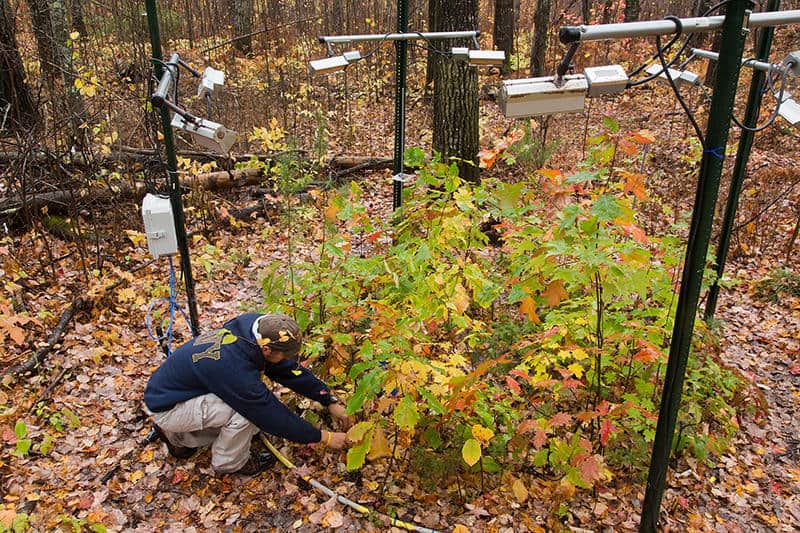
Minnesota’s northern forests, including the Quetico-Superior region, are facing big changes in the decades ahead. Global warming is expected to drastically affect what trees survive and reproduce, and which ones do not. Iconic trees like jackpine and black spruce could give way to maples and oaks.
How exactly these changes could transpire is still unknown, but University of Minnesota scientists say new research has added some detail to the predictions, in findings recently published in the journal Nature. Studies at two sites in northern Minnesota indicate that warmer weather could increase carbon dioxide (CO2) absorption, known as photosynthesis, except drier soils will offset any benefit.
“These results show that low soil moisture will slow down or eliminate any potential benefits of climate warming on tree photosynthesis even in moist, cold climates like Minnesota, Canada and Siberia,” said Peter Reich, the study’s lead author. “In a warmer future, the extra evaporation from warmer plants and soils will make those dry spells drier, further suppressing photosynthesis. As a result, low soil moisture will exert a powerful braking effect on, or even reverse, potential benefits of climate warming on tree photosynthesis even in moist, cold climates like Minnesota, Canada, and Siberia.”
The new findings are part of the lab’s B4Warmed project. It involves long-term studies at the Cloquet Forestry Center and the Hubachek Wilderness Research Center near Ely.
Climate control
To study the relationship between warming and trees, the scientists developed a system to raise temperatures and otherwise control conditions in outdoor research plots. The plots were planted with 11 species of trees found in boreal forests and the forest type just south of the region, temperate forests, which is expected to move north as the climate warms. Trees include birch, maple, oak, pine, and spruce.
Using the climate control system, they increased the temperature by about 6 degrees, which may be about what the region’s average temperatures will increase by the year 2100. Average temperatures in the region increased by 2.1 degrees Fahrenheit percent between 1862 and 2009.
For three years, the team measured how fast leaves were absorbing CO2. They found that when soils were moist, plants growing at warmer temperatures absorbed more CO2. But, the dry soils which were common through the season, reduced CO2 absorption, for an average decrease over the season.
Other ways that climate could affect canoe country include warmer winters, harming wildlife and habitat, and facilitating extreme storms and rainfall events.
The researchers say global warming could have similar effects across such forests found in the northern U.S., Canada, Europe, and northern Asia.
References
Reich, Peter & Sendall, Kerrie & Stefanski, Artur & Rich, Roy & Hobbie, Sarah & A. Montgomery, Rebecca. (2018). Effects of climate warming on photosynthesis in boreal tree species depend on soil moisture. Nature. 562. 10.1038/s41586-018-0582-4.

